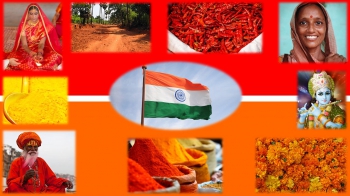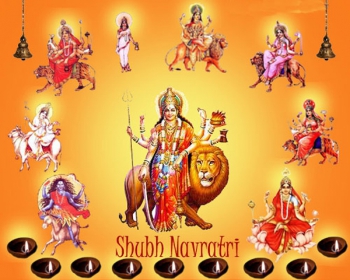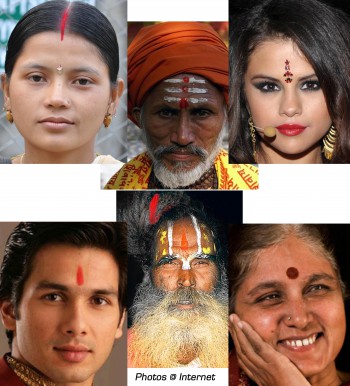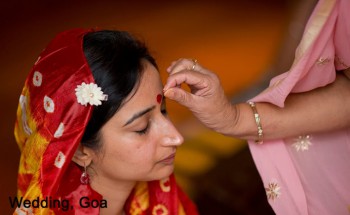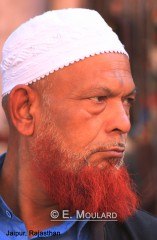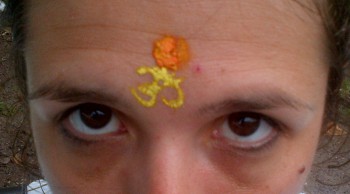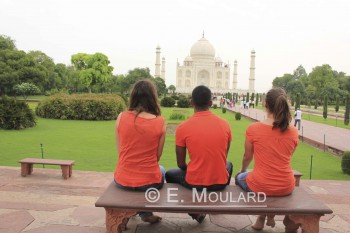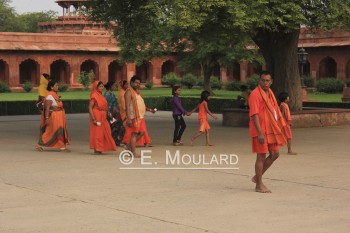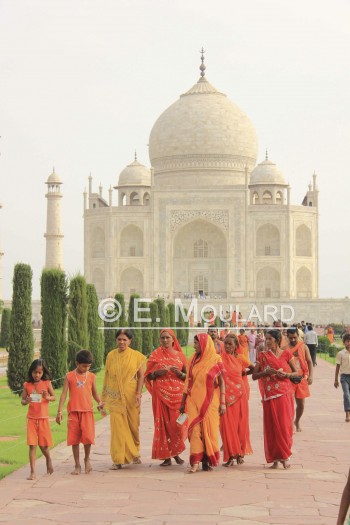09/25/2017
Why in India people don't wear black?
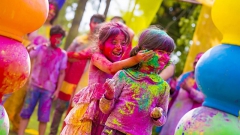 In India, colors are waltzing, everywhere, all the time. No need to wait for Holi, the festival where everyone throws colored powders and bombs to water at each other, to see red, yellow, purple, pink shimmering under the almost-daily sun. Indians wear colours on them, and it looks good. Especially Indian women.
In India, colors are waltzing, everywhere, all the time. No need to wait for Holi, the festival where everyone throws colored powders and bombs to water at each other, to see red, yellow, purple, pink shimmering under the almost-daily sun. Indians wear colours on them, and it looks good. Especially Indian women.
But why so many rainbows and no black? Is it because they see life in pink? Or because black attracts the sun's rays? If that was the reason, would it mean that Muslim women in desertic countries wearing dark colour niqabs or burqas are masochists?  Apparently, according to the Koran, black is not compulsory, whatever women cover themselves with must just be ugly, or at least it should be dull enough to not attract the (lusty) gaze of men – so much in European countries, where they get stared at for the same purpose of wearing a niqab or even just a hijab! So why do they chose black for this type of clothing? According to some, under a dark garment, as this color absorbs heat, it is so hot that you sweat, which in turn cools you down; It’s by the way the same explanation for the drinking of hot tea in burning countries. In India, the theory for tea was adopted, but not for wearing black.
Apparently, according to the Koran, black is not compulsory, whatever women cover themselves with must just be ugly, or at least it should be dull enough to not attract the (lusty) gaze of men – so much in European countries, where they get stared at for the same purpose of wearing a niqab or even just a hijab! So why do they chose black for this type of clothing? According to some, under a dark garment, as this color absorbs heat, it is so hot that you sweat, which in turn cools you down; It’s by the way the same explanation for the drinking of hot tea in burning countries. In India, the theory for tea was adopted, but not for wearing black.
 But why? Why is black colour has a negative connotation in spirituality and superstition (1)? Would it simply because it attracts mosquitoes, according to the popular belief – or at least to the belief of my nanny and my neighbor? CNN says it’s a myth. But the expert, in the interview, also says that what attracts mosquitoes is the carbon dioxide emitted by the body and the body heat. It goes in the sense of Muslim theories: we sweat more under a dark garment, and therefore the skin produces more carbon dioxide; and more definitely more heat since black absorbs it from the sun. So maybe it’s not completely a myth. And myth or not myth, I have noticed that mosquitoes prefer to rest on the dark things (door, bed, mirror) rather than on my white walls - and I have always thought they were shrewd enough to master camouflage techniques! (PS: did you know? Mosquitoes feed on plant nectar and don’t need blood as food but as a protein intake related to reproduction; vampires are all females!)
But why? Why is black colour has a negative connotation in spirituality and superstition (1)? Would it simply because it attracts mosquitoes, according to the popular belief – or at least to the belief of my nanny and my neighbor? CNN says it’s a myth. But the expert, in the interview, also says that what attracts mosquitoes is the carbon dioxide emitted by the body and the body heat. It goes in the sense of Muslim theories: we sweat more under a dark garment, and therefore the skin produces more carbon dioxide; and more definitely more heat since black absorbs it from the sun. So maybe it’s not completely a myth. And myth or not myth, I have noticed that mosquitoes prefer to rest on the dark things (door, bed, mirror) rather than on my white walls - and I have always thought they were shrewd enough to master camouflage techniques! (PS: did you know? Mosquitoes feed on plant nectar and don’t need blood as food but as a protein intake related to reproduction; vampires are all females!)
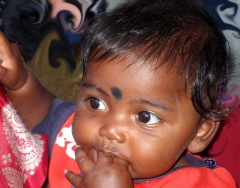 (1) Black is the color of evil, negativity and inertia; It symbolizes anger, darkness and is associated with the lack of energy, death though it is not the color of mourning. As a representation of evil, it is also used to combat the latter – take the form of the enemy to defeat him – as can be seen in the black dot applied on the face of infants to keep the dark evil eye at bay.
(1) Black is the color of evil, negativity and inertia; It symbolizes anger, darkness and is associated with the lack of energy, death though it is not the color of mourning. As a representation of evil, it is also used to combat the latter – take the form of the enemy to defeat him – as can be seen in the black dot applied on the face of infants to keep the dark evil eye at bay.
White is the absence of color; It’s the ‘non-color' worn at funerals and by widows throughout the rest of their lives, as a sign of renouncing all the pleasures/colors of life.
Red symbolizes violence, the fire that burns and therefore also the purity – in India fire has purifying virtues. It is also the color for the bride’s sari. Red also has connotations of sensuality, fertility and prosperity. Women wear a red dot on the forehead (see more about tilak, sindoor and bindi here). Favorite chilis are red. The super fertile earth is red in some areas. Orange or saffron, is the real color of fire and purity; When it is worn, it indicates its bearer has renunced the world and is in a quest for the sacred.
The yellow of the turmeric symbolizes holiness, blue is associated with the god Krishna, green represents renewal and joy. If you dig a little more, each color is associated with a certain God or goddess and represents its main qualities.
During the Holi festival: the pigments they throw at one another have very specific meanings: green for harmony, orange for optimism, blue for vitality and red for joy and love” (source: Wikipedia).
Another example is the color dress code to be observed during Navratri (from 21 to 29 September this year). Each of the 9 days of the festival is dedicated to one of the forms of the goddess Durga.
- Day 1 - Pratipada, goddess as ‘daughter of the mountains’ and consort of Shiva – Red for action and strength
- Day 2 - Brahmacharini, dispenser of happiness and prosperity – royal Blue for a quiet but powerful energy
- Day 3 - Chandraghanta, the goddess with a half moon on the forehead represents the beauty and the courage of the one fighting against the demons – Yellow, color that warms the heart
- Day 4 - Kushmanda, who created the universe covered with green vegetation – Green
- Day 5 - Skand Mata, who holds the infant Karthik in her arms – Gray for the vulnerability of the mother (who can turn into storm clouds to protect her little)
- Day 6 - Katyayani, when she was reborn as the daughter of the sage Kata as per his wish – Orange for courage
- Day 7 - Kalratri, black as night and very angry – White as her garment, and for peace and prayer
- Day 8 - The goddess is dressed in pink and destroys all sins of all times – Pink for a fresh start and renewal
- Day 9 - Siddhidatri with supernatural powers of healing – light Blue, like the cloudless sky
Sources: http://www.sensationalcolor.com/color-meaning/color-around-the-world/India-country-symbolic-colors-1935#.WB-kCMbYXIU ; https://www.theindusparent.com/significance-of-colours-in...
https://www.nbcnews.com/health/why-some-people-are-mosqui... ; http://Edition.CNN.com/2014/07/04/health/mosquito-bites-m...
08:00 Posted in Funny things about India in photos, Why in India... | Permalink | Comments (0) | Tags: india, colours, black, white, red, orange, blue, religion, spirituality, holi, navratri, durga, colour code, red dot on the forehead | ![]() Facebook | |
Facebook | |
10/14/2013
Why in India people have red marks on the forehead?
Or, if we dig deeper, Who, when, how, where?
We can distinguish different ‘marks’: the dot in the middle forehead, the line at the root of the hair and the lines and other designs on the forehead. These marks are often red, but not always. It’s not easy to understand the whole thing!
So who wears what? Does a red dot mean a woman is married?
In North India, the red dot on the forehead would be traditionally the prerogative of married women. But not in South India. Anyway it has become a fashion element, which varies in shape, color and material (the sticker – top right photo – has been giving tough competition to the traditional bindi – bottom right).
It seems however that the sindoor applied at the root of the hair (top left) is only applied by married women (a way of saying don’t touch! – like others do with a ring!).
Men can also wear the tilak, for religious or aesthetic reasons.
In fact anyone (Hindu or not, man or woman, Indian or not) will bear a red mark on the forehead after attending a puja (religious ceremony): whether it's a small prayer at home or in the temple, it always ends by a marking on the forehead...
So... why?
Firstly for aesthetic reasons: Indians find it beautiful! Tastes and colors are not to be discussed...
Secondly the dot on the forehead is a Hindu religious symbol since the tilak, placed on the sixth chakra (‘agna’), represents the third eye or the eye of the mind, associated with deities and the concepts of meditation and spiritual enlightenment. It was originally exclusively for ‘knowledge holders’: idols, priests, ascetics. (1) The Vishnu worshippers’ tilak is a U of white color (obtained from sandalwood) drawn around a red or black line (bottom middle photo). And for Shivaites it is formed by three horizontal lines made from ashes (top middle). (2)
But above all there is a 'scientific' explanation: the body– the forehead and the point 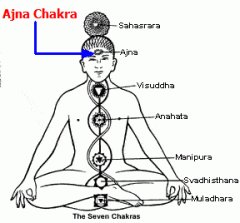 between the two eyes (seat of memory and thoughts) in particular – would produce energy in the form of electromagnetic waves. That’s how stress or anxiety creates heat and causes headaches. (1)
between the two eyes (seat of memory and thoughts) in particular – would produce energy in the form of electromagnetic waves. That’s how stress or anxiety creates heat and causes headaches. (1)
In Tantrism, during meditation, energy flows from the base to the head and leave the body by this point; hence the idea of "plugging the hole" to retain the energy inside. (3)
It is therefore to protect themselves and avoid energy losses that Hindus mark their forehead with a soothing and cooling powder paste.
Indeed, if the 'mark' varies in shape, colour, material and name ('tika', 'pottu', 'sindoor', 'tilak', 'tilakam', 'kumkum' and 'bindi', 'vermilion'), the traditional base (kumkum powder) is obtained by adding a few drop of lime to the yellow turmeric powder which then turns red (and add a little water to make it a paste). Some recipes contain saffron. And it turns out that both turmeric and saffron have medicinal properties as pain-killers! (4)
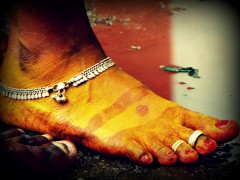 Turmeric is very present in the Indian culture. For example, in Andhra Pradesh, women used to apply it on (and under) the feet every day to protect them (because there were not too many shoes at the time (not that everyone wears shoes today either)). (5)
Turmeric is very present in the Indian culture. For example, in Andhra Pradesh, women used to apply it on (and under) the feet every day to protect them (because there were not too many shoes at the time (not that everyone wears shoes today either)). (5)
Indians may not have invented hot water* (not that they really need it anyways!) but their knowledge about medicinal plants is simply fascinating! Take henna. Not only is it cooling,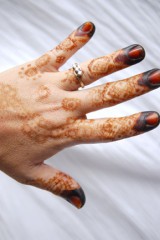 but also it is a coagulant for open wounds. Hence the tradition of Indian women to apply henna on their fingertips to protect themselves from the injuries inherent to manual chores. (6)
but also it is a coagulant for open wounds. Hence the tradition of Indian women to apply henna on their fingertips to protect themselves from the injuries inherent to manual chores. (6)
Here I owe an apology to my mother... After asking a thousand questions she came up with this one: “Tell me, why do these men have orange hair and beard?” I was a little bit upset with myself for not knowing the answer so I just told her whatever non-sense came to my mind: it is because they have used a bad quality dye which has faded!
In fact it seems that some men voluntary decide to have orange hair by dying it with henna. Apparently it could be because some Indians want to hide their gray hair but don’t have enough money to buy a good quality (black) dye. (7) The use of henna can also be linked to religion, as Islam would prohibit any dye except for henna. (8) When I asked my salesguy why do some people have orange hair he just told me that when people start to have gray hair they dye it, sometimes in black, sometimes in orange. No need to overthink it! You see Mum… ;)
* Sheer provocation?? Not only ! Apart from the zero, difficult to think of anything Indians actually invented… It doesn’t mean they are dumb though… They have stuff like the jugaad (in very short, “the gutsy art of overcoming harsh constraints by improvising an effective solution using limited resources”). Read more here.
(2) http://fr.wikipedia.org/wiki/Tilak
(3) http://hinduism.about.com/od/bindis/a/bindi.htm
(4) http://www.safrandugatinais.fr/en/vertus.htm; http://www.healthdiaries.com/eatthis/20-health-benefits-of-turmeric.html
(5) http://www.nandyala.org/mahanandi/?p=925
(6) http://www.ft.com/cms/s/0/d2933fb0-83de-11dc-a0a6-0000779fd2ac.html#ixzz2fW2qoFNh
(7) http://www.earthhenna.com/c158/c105/c98/The-Henna-Plant-c104.html
(8) http://ask.metafilter.com/88073/Why-would-a-Muslim-man-use-henna-to-dye-his-beard-orange
08:00 Posted in Why in India... | Permalink | Comments (0) | Tags: hair, hairs, beard, jugaad, innovation, orange, dye, henna, turmeric, saffron, spices, red dot, red mark, forehead, chakra, energy, meditation, third eye, tika, pottu, sindoor, tilak, tilakam, kumkum, bindi, agna, puja, kumkum powder, vermilion, orange hair | ![]() Facebook | |
Facebook | |
07/30/2012
Seeing life in orange...
Here is what happens when I decide to do things differently... And dress up funny to see the Taj with my friends!!
We throw in a few ideas, most of them impractical since my friends are visiting and don't have so many clothes... And it so happens that it is only in orange that I have 3 tee-shirts!! So here we go, we will be the orange team!!
But the story doesn't stop here... Everyone seems to have had the same idea!!
Well actually it turns out the Shiva processions from Delhi to Haridwar have started and Agra is on the way... And the pilgrims' colour is orange...
So much for being oranginal!!
08:00 Posted in Funny things about India in photos, My stories in India | Permalink | Comments (0) | Tags: india, agra, taj, orange, shiva pilgrims | ![]() Facebook | |
Facebook | |















